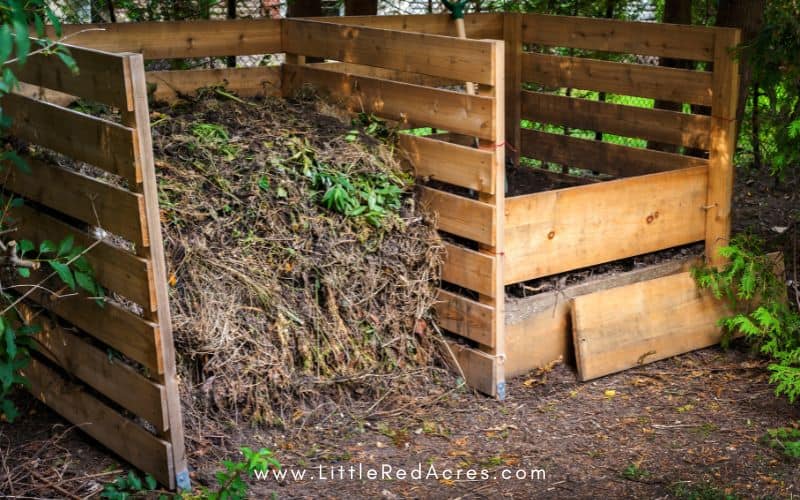Step-by-Step Instructions: Crafting the Perfect Compost Pile
Inside: Master the art of composting with our easy step-by-step guide. Learn how to create a nutrient-rich compost pile to enrich your garden soil and support plant growth.
Composting is like creating a special recipe for your garden's soil. It's about mixing just the right ingredients in the right way to cook up something that will make your plants thrive. But where do you start? What do you need? And how do you ensure your compost pile turns into black gold instead of a smelly mess? Fear not!

This post may contain affiliate links, see my disclosure policy for more information.
Step-by-Step Instructions: Crafting the Perfect Compost Pile
Composting isn't just about throwing kitchen scraps and yard waste into a pile and hoping for the best. It's an art that, when done correctly, can transform your garden. Let's walk through each step to create the perfect compost pile, from selecting the right spot to maintaining the balance of greens and browns.
Whether you're a seasoned gardener or a green-thumbed newbie, you'll find tips and tricks to make your compost pile the envy of the neighborhood.
We'll cover choosing the right location, balancing “greens” and “browns,” the importance of moisture and air, and how to tell when your compost is ready to use.
Get updates & freebies delivered to your inbox!
Step-by-Step Guide to Crafting the Perfect Compost Pile
Composting is a bit like magic. You take kitchen scraps, yard waste, and other organic materials, and with a little time and care, they transform into nutrient-rich gold for your garden. Not only does composting reduce waste sent to landfills, but it also provides your plants with the nutrients they need to grow strong and healthy. Ready to start your composting journey? Follow these steps to create the perfect compost pile.
Choose the Right Spot
First things first, pick a spot in your yard that's flat, well-drained, and easily accessible. You'll want a location that gets some sun, but not too much—partial shade is ideal to keep the pile from drying out too quickly.
Also, consider proximity to your garden and a water source; you'll need to add moisture to the pile, and you don't want to be hauling water across your yard in the heat of summer.

Start with a Layer of Browns
Your compost pile needs a good balance of “greens” (nitrogen-rich materials like vegetable scraps, coffee grounds, and grass clippings) and “browns” (carbon-rich materials like dried leaves, straw, and paper).
Start your pile with a layer of browns at the bottom. This layer helps with drainage and aeration, setting the stage for successful composting.
Add Your Greens
After the brown layer, add your greens. Try to keep a rough ratio of 3 parts browns to 1 part greens by volume. This balance helps speed up the decomposition process while keeping odors at bay.
If your pile starts to smell, it's a sign you might have too many greens. Add more browns to even things out.
Keep It Moist
Moisture is crucial for composting, but you don't want your pile to be too wet or too dry. The ideal moisture level is like a wrung-out sponge.
If the pile is too dry, add water or more green material. If it's too wet, add more browns to absorb the excess moisture.

Turning the Compost Pile
Aeration is another key component of successful composting. You need to turn your pile with a garden fork every few weeks to introduce air into the mix.
This helps speed up the decomposition process and prevents your pile from becoming compacted and smelly.
Know When Your Compost Pile is Ready
Your compost is ready to use when it's dark, crumbly, and smells like earth.
This process can take anywhere from a few months to a year, depending on factors like the balance of materials, the size of the pile, and the weather.
Once ready, you can mix it into your garden soil or use it as mulch.

Compost Pile Troubleshooting Tips
- Pile too smelly? Add more browns to balance out the greens.
- Compost not breaking down? Make sure it's moist enough and turn it more frequently to introduce air.
- Attracting pests? Avoid adding meat, dairy, and oily foods to your pile, and consider a compost bin with a lid.
Composting is a rewarding practice that benefits your garden and the planet. By following these steps, you'll be well on your way to creating a thriving compost pile that provides endless benefits for your garden. Happy composting!
Frequently Asked Questions
Can I compost cooked food? It's best to avoid composting cooked food, especially if it contains meat, dairy, or oil, as it can attract pests and produce odors.
How big should my compost pile be? A pile that's about 3 feet wide by 3 feet tall is ideal. This size is large enough to retain heat and encourage decomposition but not so large that it becomes difficult to manage.
Can I compost paper and cardboard? Yes, but shred them first to speed up decomposition. Avoid glossy or colored paper, as it may contain harmful chemicals.

Want More?
What To Do With Chicken Coop Waste
Tips For Starting An Organic Garden






